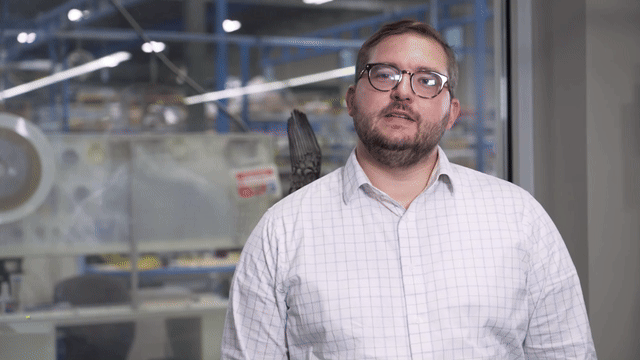What’s Included in My Quote?
You finally have the custom tape quote in your hands, but your eyes glaze over as you try to piece it together.
Looking at quotes quickly becomes frustrating when they’re challenging to read. If you watch for these four elements, you’ll have a far easier time understanding the components that make up your custom tape quote.
1. LEAD TIME

If the first question is, “How much will my die cuts cost?” then the following question is, “When will you have them ready?”
The project lead time, shown at the top of your quote, refers to how long it'll be before you receive your product.
Your overall lead time is made up by multiple factors:
- Tooling lead time
- Material lead time
- Press availability
Die cut tooling and material are both subject to lead times, which may take longer depending on part complexity. Typically, material lead time is the longest. As for press availability, we review all our active machines, operators, and projects before scheduling your part.
If you’re interested in reducing your lead times, ordering in advance and providing more upfront information about your design can reduce the time it takes to fill a quote as well as your overall project lead time.
2. QUANTITY

The quantity listed on your custom tape quote is the total number of units your converter builds.
One important thing to note about part quantity is that the unit M on your quote refers to numbers in the thousands. Therefore, the amount listed in the image above as 100 M means 100,000 parts.
Multiple quantities are often provided to demonstrate how costs change when you scale up your order, which can reduce the price per part. You’ll notice that, like buying anything else in bulk, your unit price lowers significantly as the quantity increases. In a moment, you’ll see how the unit and total prices cause this phenomenon and why it exists.
Lastly, if there is a specific quantity you wish to be quoted, make sure to let us know.
3. UNIT PRICE


The unit price refers to the cost of the listed quantity of individual parts, bags, or kits, depending on the product.
If your unit is in eaches, the unit price is not the Price Per Part (PPP). In the example above, the unit is M, the unit price is $1,000, and the quantity is 100 M. You can divide these to find your price per part:

4. TOTAL PRICE

Your total price is the overall cost estimate for the quantity listed. If you’re wondering how this cost breaks down or want to read more about the factors that impact the total price, you can read more about the cost of a die cut.
Multiplying unit price by quantity will also give you your total cost.
How Can I Compare My Custom Tape Quote to Others?
Like desperate carnival barkers trying to sell tickets, many different converters will try to lure you in for sales. So, how do you find a manufacturer that stands out amidst the noise?
Here are a couple of factors to consider when choosing adhesive companies:
a. LOOK AT THEIR MATERIALS
If one quote lists the material as $1.00 and the other as $0.01, consider why it costs significantly more.
- Are they using the same material?
If there’s a price difference on the same material, consider why that is: does one converter get a special deal? Or are they simply covering an expense without telling you? If the difference seems significant, it’s worth asking your converter why.
- Does the cheaper material have worse quality?
Poor quality materials often lead to increased part defects and waste. Both of these factors drain time and money, so you might be better off without their support than with them.
- Does the material fit ALL your requirements?
When consulting your converter on the suitable material, it’s only natural to emphasize everything you want your part to have. However, it can also be helpful to stress the importance of certain aspects over others.
If you need incredibly precise die cut tolerances, you’ll want your converter to know about it. Likewise, if your tolerances don’t matter as much, you could save money on a cheaper material that still does the job.
b. CONSIDER THEIR QUALITY SYSTEM
Nobody wants faulty parts, but what systems does your converter have to prevent them? Do they have a quality-checking team, or should you check each piece personally?
If converters produce an excess number of defective or particle-contaminated parts, it’ll cost you thousands in wasted press time and materials. Similarly, it’s worth asking whether your converter has certifiable sterile processing Cleanroom capabilities.
Don’t fall for a lower initial price without checking to ensure you aren’t signing up for a myriad of future problems.
c. THINK ABOUT APPLICATION
Building a product takes more than the production itself; it has to function well to succeed.
Before you choose a converter, you’ll want to decide whether your product will be in roll or sheeted form and whether your adhesive will peel for application.

Is the total price higher because one converter offered to add a tab to the design for accessibility? Or because they offered to deliver your products in sheet form? A higher price might be worth the value if the end goal is a successful product that functions quickly and effectively.
Choosing the Quote That Suits Your Purpose
Each converter has strengths and weaknesses, so you should choose the one that best suits your product's purpose. As previously mentioned, this includes your material, quality, and application requirements.
If you’re interested in a company that will offer advice, listen to your feedback, and build your product as effectively as possible, contact Strouse.
Strouse’s more than 38 years of experience contribute to a highly successful complex design manufacturing strategy and process. Your quote will be fully customized to the unique needs of your adhesive solution.
Take a look at the guide above to learn about Strouse’s capabilities and your project timeline. Finally, if you have any questions, feel free to email us or review the resources located in our Learning Center.
Originally published: January 16, 2023







